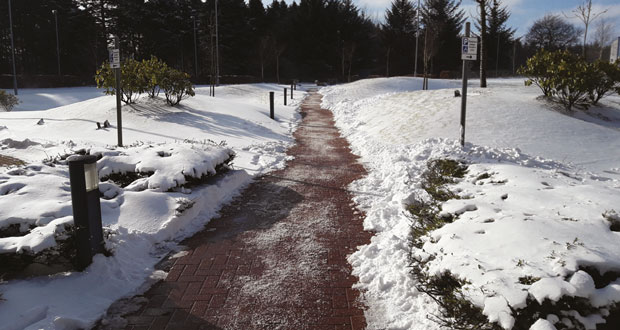Frost proof
 Facilities managers face increased risk and liability during winter months, but proper planning now can prevent disruption, injury, and financial loss, says Nik Tozer, Managing Director of winter gritting at Nurture Group
Facilities managers face increased risk and liability during winter months, but proper planning now can prevent disruption, injury, and financial loss, says Nik Tozer, Managing Director of winter gritting at Nurture Group
Don’t wait for the first frost, winter readiness starts now. Because of recent record-warm winters, many companies rely on reactive rather than proactive gritting, which is a costly mistake. The truth is though that long range forecasts are unpredictable, and the only thing guaranteed is that risk increases without proper preparation.
Snow and ice can cause significant damage to infrastructure, from cracked pavements to overloaded roof structures. Regular, year-round maintenance is essential to reduce the risk of costly repairs and keep your site running smoothly during winter weather.
Facilities managers should also devise a proactive gritting strategy to avoid the high costs that could be incurred from a reactive approach. Businesses can incur unexpected costs by acting upon, instead of preparing for, events such as slip and fall claims, or other operational disruption during cold weather. The resulting legal and reputational risks of not being prepared could cause irreparable damage.
PROACTIVE GRITTING STRATEGIES
A proactive approach to winter gritting means planning ahead to minimise the impact of winter weather and protect the safety of all individuals accessing the premises.
The first stage in any gritting strategy is to monitor and forecast the weather conditions, ensuring access to real-time weather data and other forecasting tools to help predict when and where the freezing conditions will occur. Daily forecasts from reputable sources like the Met Office can help to accurately assess the weather situation, allowing for the allocation of the necessary resources, equipment and manpower to the areas that require immediate attention.
This first important step will allow facilities managers to anticipate freezing conditions before they happen.
Once a monitoring procedure is in place, a route around the site or priority areas can be planned, to ensure resources are efficiently deployed based on the needs of the business. Tailoring this is crucial in the context of winter gritting. Every property has unique needs and facilities managers should optimise the allocation of resources to provide effective solutions that address the individual challenges of each site. For example, a school, hospital, commercial office, logistics hub and industrial site will all have differing needs.
If this stage of the gritting strategy is followed successfully, then access will be maintained to critical areas and the site can function normally during inclement weather.
The gritting materials should also be chosen in advance. There may be a variety of options available dependent on the location and supply chain, for example white marine salt or rock salt.
After stages one and two are in place, it’s time to execute and adapt to ensure the site is secure before any frost or snow hits. With continual monitoring before, during and after deployment of the gritting or snow clearing, the team can respond to unexpected changes and maintain the continued safety of users at the site. By taking this proactive approach, visitors and stakeholders will have confidence in the organisation’s commitment to safety.
LEGAL AND INSURANCE IMPLICATIONS
Planning and implementing a proactive gritting strategy is not just an important way of maintaining an organisations reputation and insure against costly incidents, it’s about remaining compliant with health and safety and employment laws. Compliance with health and safety regulations is an integral part of upholding a duty of care, avoiding potential lawsuits and fines. This is why the site risk assessment should be kept updated to identify potential hazards, assess the risk of an accident occurring and determine what preventative actions should be taken. This can then form part of the gritting strategy.
The post Frost proof appeared first on FMJ.

